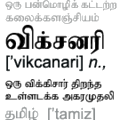How free can word order be?
I've learnt that some languages like Sanskrit are declensional to the point that word order is totally free. If so, how would they map qualifiers like adjectives and adverbs with their corresponding nouns and verbs when there is more than one possible combination? Can someone give examples? How would they differentiate between the two following senses?
Only, he went too far.
He went only too far.
Update: Learned people from Wikipedia Reference Desk inform that free word order does sometimes cause ambiguity, but most declensional languages help resolve them with the context. Well, what's the fun without room for ambiguity in language! As an aside, I find that for serious technical questions Wikipedia Reference Desk may be a better place (as of now) than Yahoo! Answers. However, good questions and answers have started coming into the latter.
Follow-up update: Yahoo! Answers is not all that bad. It did give an authoritative answer for my question. Below is the answer given by a linguist:
There is no language where word order is totally free. That is a myth. There are two strategies for marking the relationship of qualifier-qualified. The first is word order. The adjective occurs right next to the noun it modifies (or the adverb next to the adjective/adverb/verb it modifies). The strategy that is usually adopted in languages with a highly marked declensional system is that the adjective carries a similar or identical declensional ending to the noun it modifies. In the case of adverbs, word order is still generally the means used.



0 Comments:
Post a Comment
<< Home